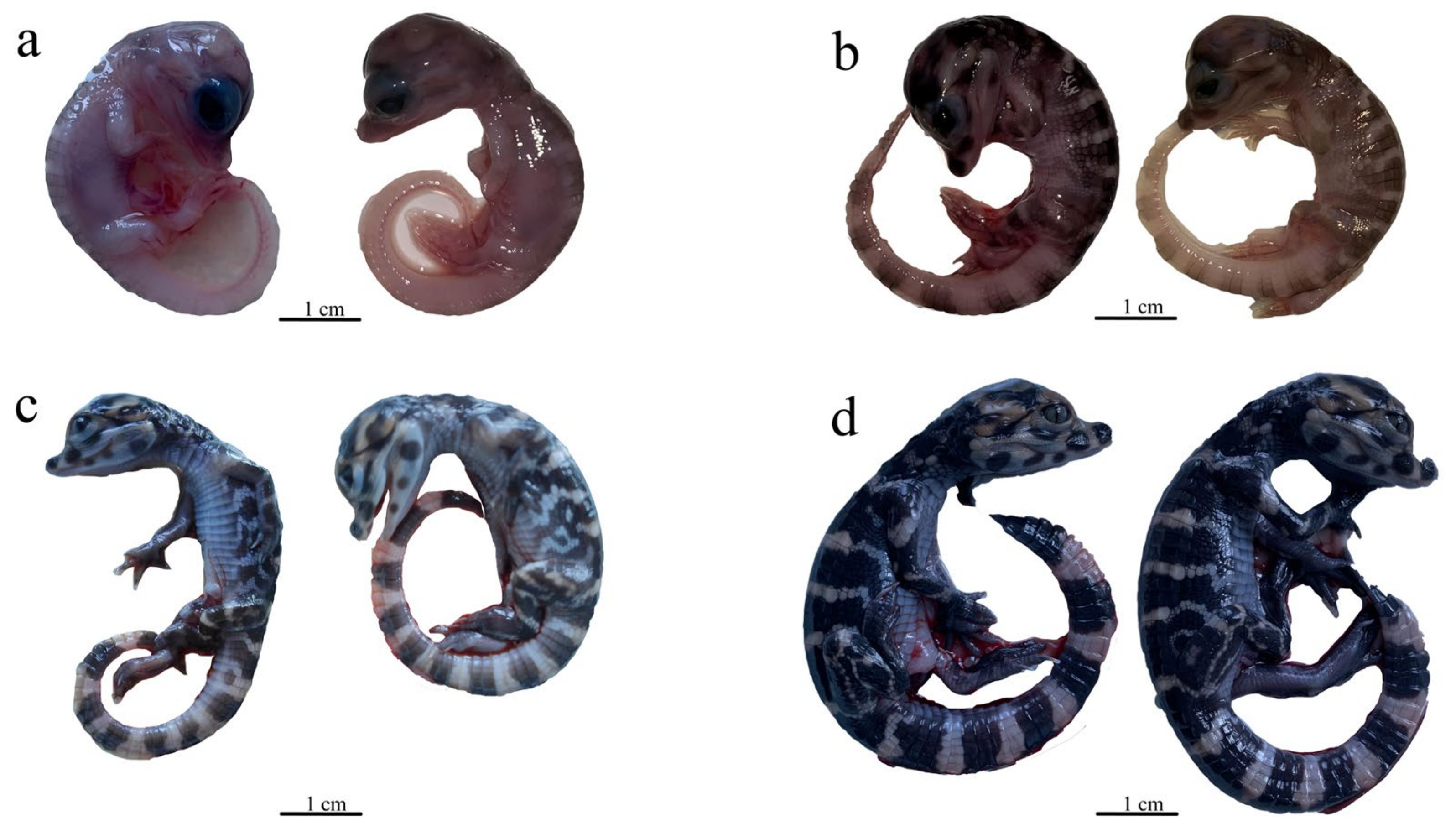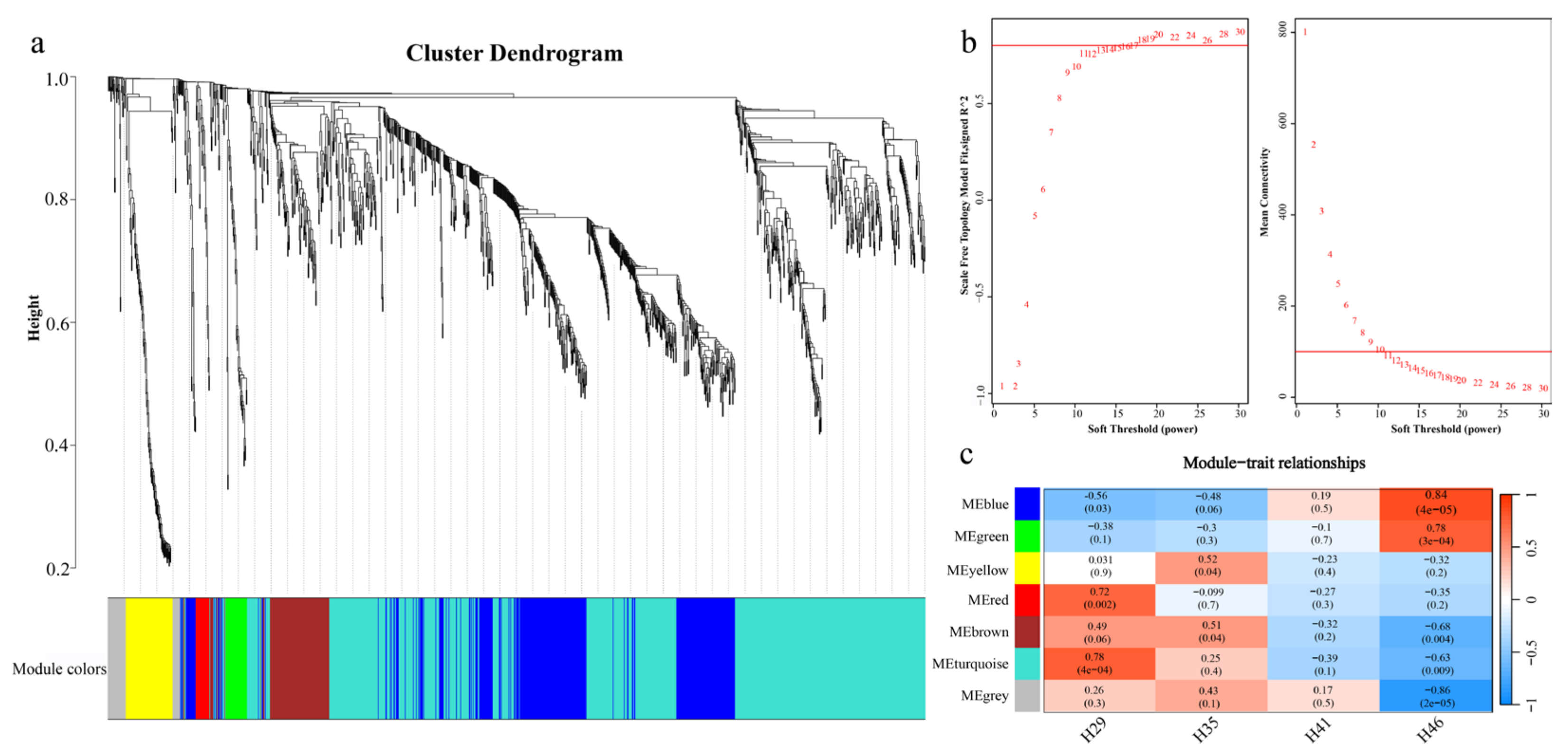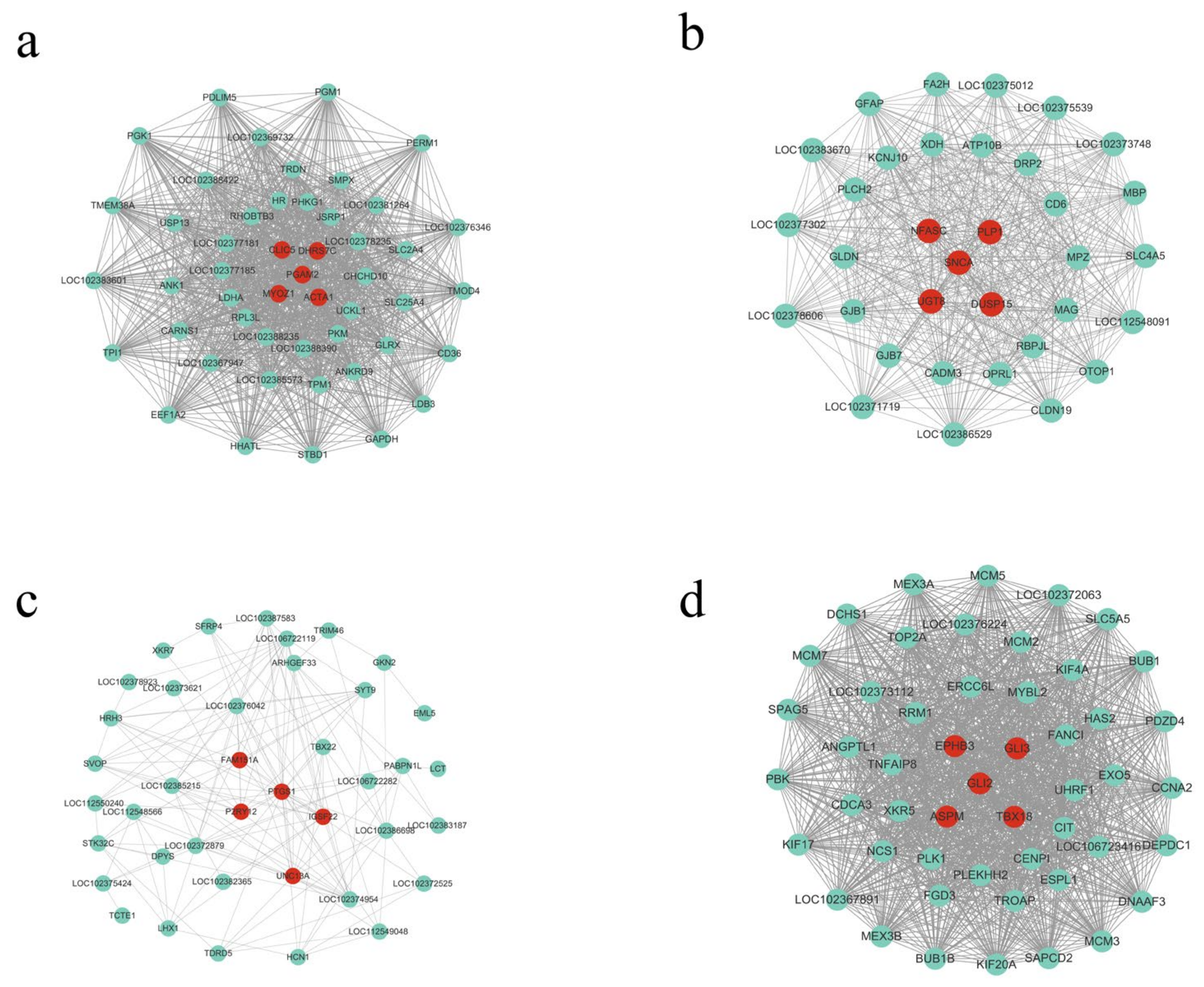Candidate Regulatory Genes for Hindlimb Development in the Embryos of the Chinese Alligator (Alligator sinensis)
Abstract
Simple Summary
Abstract
1. Introduction
2. Materials and Methods
2.1. Animals and Sample Preparation
2.2. RNA Isolation, cDNA Library Construction, and Illumina Deep Sequencing
2.3. Assembly and Functional Annotation
2.4. Identification of Differentially Expressed Genes
2.5. Co–Expression Network Analysis and Visualisation
2.6. Functional Enrichment Analysis
2.7. Expression Analysis via Quantitative Real-Time PCR (qRT-PCR)
3. Results
3.1. Sequencing and Assembly Analyses
3.2. Analysis of Differentially Expressed Genes (DEGs)
3.3. Co–Expression Network Analysis and Visualization
3.4. Visualization of Significant Modules and Key Genes
3.5. Functional Enrichment Analysis
3.6. Validation of RNA-Seq via qRT-PCR
4. Discussion
5. Conclusions
Supplementary Materials
Author Contributions
Funding
Institutional Review Board Statement
Informed Consent Statement
Data Availability Statement
Conflicts of Interest
References
- Mohammadabadi, M.; Bordbar, F.; Jensen, J.; Du, M.; Guo, W. Key genes regulating skeletal muscle development and growth in farm animals. Animals 2021, 11, 835. [Google Scholar] [CrossRef] [PubMed]
- Miao, Z.; Han, Z.; Zhang, T.; Chen, S.; Ma, C. A systems approach to a spatio-temporal understanding of the drought stress response in maize. Sci. Rep. 2017, 7, 6590. [Google Scholar] [CrossRef]
- Zinzen, R.P.; Girardot, C.; Gagneur, J.; Braun, M.; Furlong, E.E. Combinatorial binding predicts spatio-temporal cis-regulatory activity. Nature 2009, 462, 65–70. [Google Scholar] [CrossRef] [PubMed]
- Rowlerson, A.; Mascarello, F.; Radaelli, G.; Veggetti, A. Differentiation and growth of muscle in the fish Sparus aurata (L): II. Hyperplastic and hypertrophic growth of lateral muscle from hatching to adult. J. Muscle Res. Cell Motil. 1995, 16, 223–236. [Google Scholar] [CrossRef] [PubMed]
- Chargé, S.B.; Rudnicki, M.A. Cellular and molecular regulation of muscle regeneration. Physiol. Rev. 2004, 84, 209–238. [Google Scholar] [CrossRef] [PubMed]
- Berchtold, M.W.; Brinkmeier, H.; Muntener, M. Calcium ion in skeletal muscle: Its crucial role for muscle function, plasticity, and disease. Physiol. Rev. 2000, 80, 1215–1265. [Google Scholar] [CrossRef] [PubMed]
- Coral-Vazquez, R.; Cohn, R.D.; Moore, S.A.; Hill, J.A.; Weiss, R.M.; Davisson, R.L.; Straub, V.; Barresi, R.; Bansal, D.; Hrstka, R.F. Disruption of the sarcoglycan–sarcospan complex in vascular smooth muscle: A novel mechanism for cardiomyopathy and muscular dystrophy. Cell 1999, 98, 465–474. [Google Scholar] [CrossRef] [PubMed]
- Gal-Levi, R.; Leshem, Y.; Aoki, S.; Nakamura, T.; Halevy, O. Hepatocyte growth factor plays a dual role in regulating skeletal muscle satellite cell proliferation and differentiation. Biochim. Biophys. Acta Mol. Cell Res. 1998, 1402, 39–51. [Google Scholar] [CrossRef]
- Webster, C.; Silberstein, L.; Hays, A.P.; Blau, H.M. Fast muscle fibers are preferentially affected in Duchenne muscular dystrophy. Cell 1988, 52, 503–513. [Google Scholar] [CrossRef]
- Wigmore, P.; Stickland, N. Muscle development in large and small pig fetuses. J. Anat. 1983, 137, 235. [Google Scholar]
- Delgado, I.; Giovinazzo, G.; Temiño, S.; Gauthier, Y.; Balsalobre, A.; Drouin, J.; Torres, M. Control of mouse limb initiation and antero-posterior patterning by Meis transcription factors. Nat. Commun. 2021, 12, 3086. [Google Scholar] [CrossRef] [PubMed]
- Berenguer, M.; Duester, G. Role of retinoic acid signaling, FGF signaling and meis genes in control of limb development. Biomolecules 2021, 11, 80. [Google Scholar] [CrossRef] [PubMed]
- Rochlin, K.; Yu, S.; Roy, S.; Baylies, M.K. Myoblast fusion: When it takes more to make one. Dev. Biol. 2010, 341, 66–83. [Google Scholar] [CrossRef] [PubMed]
- Dobi, K.C.; Schulman, V.K.; Baylies, M.K. Specification of the somatic musculature in Drosophila. Dev. Biol. 2015, 4, 357–375. [Google Scholar] [CrossRef] [PubMed]
- Du, M.; Tong, J.; Zhao, J.; Underwood, K.; Zhu, M.; Ford, S.; Nathanielsz, P. Fetal programming of skeletal muscle development in ruminant animals. J. Anim. Sci. 2010, 88, E51–E60. [Google Scholar] [CrossRef] [PubMed]
- Wang, J.S.; Infante, C.R.; Park, S.; Menke, D.B. PITX1 promotes chondrogenesis and myogenesis in mouse hindlimbs through conserved regulatory targets. Dev. Biol. 2018, 434, 186–195. [Google Scholar] [CrossRef] [PubMed]
- Nemec, S.; Luxey, M.; Jain, D.; Sung, A.H.; Pastinen, T.; Drouin, J. Pitx1 directly modulates the core limb development program to implement hindlimb identity. Development 2017, 144, 3325–3335. [Google Scholar] [CrossRef] [PubMed]
- Willmer, P.; Stone, G.; Johnston, I. Environmental Physiology of Animals; John Wiley & Sons: Hoboken, NJ, USA, 2009. [Google Scholar]
- Bock, W.J.; Von Wahlert, G. Adaptation and the form-function complex. Evolution 1965, 19, 269–299. [Google Scholar] [CrossRef]
- Chen, B.; Hua, T.; Wu, X.; Wang, C. Research on the Chinese Alligator; Shanghai Science and Technology Education Press: Shanghai, China, 2003. (In Chinese) [Google Scholar]
- Grigg, G.; David, K. Biology and Evolution of Crocodylians; Cornell University Press: New York, NY, USA, 2015. [Google Scholar]
- Zhang, J.; Cai, R.; Liang, J.; Izaz, A.; Shu, Y.; Pan, T.; Wu, X. Molecular mechanism of Chinese alligator (Alligator sinensis) adapting to hibernation. J. Exp. Zool. B Mol. Dev. Evol. 2021, 346, 32–49. [Google Scholar] [CrossRef]
- Zeng, C.; Ye, Q.; Fang, S. Establishment and cryopreservation of liver, heart and muscle cell lines derived from the Chinese alligator (Alligator sinensis). Chin. Sci. Bull. 2011, 56, 2576–2579. [Google Scholar] [CrossRef][Green Version]
- Grigg, G.; Gans, C. Morphology and Physiology of the Crocodylia; Australian Government Publishing Service: Canberra, Australia, 1993. [Google Scholar]
- Fleagle, J.G. Primate Adaptation and Evolution; Academic Press: Cambridge, MA, USA, 2013. [Google Scholar]
- Hua, T.; Hua, Z.; Chen, B.; Wang, C. Morphogenesis of the Limb of Chinese Alligator. J. Anhui Norm. Univ. 1995, 18, 38–41. (In Chinese) [Google Scholar]
- Hua, T.; Wang, C.; Chen, B. Stages of Embryonic Development for Alligator sinensis. Zool. Res. 2004, 25, 263–271. [Google Scholar]
- Grabherr, M.G.; Haas, B.J.; Yassour, M.; Levin, J.Z.; Thompson, D.A.; Amit, I.; Adiconis, X.; Fan, L.; Raychowdhury, R.; Zeng, Q. Trinity: Reconstructing a full-length transcriptome without a genome from RNA-Seq data. Nat. Biotechnol. 2011, 29, 644. [Google Scholar] [CrossRef] [PubMed]
- Bray, N.L.; Pimentel, H.; Melsted, P.; Pachter, L. Near-optimal probabilistic RNA-seq quantification. Nat. Biotechnol. 2016, 34, 525–527. [Google Scholar] [CrossRef] [PubMed]
- Zhu, H.; Zhang, S.; Zhou, Y.; Wang, C.; Wu, X.G.; Research, M. Cloning and sequence analysis of the coding sequence of β-actin cDNA from the Chinese alligator and suitable internal reference primers from the β-actin gene. Genet. Mol. Res. 2015, 14, 12159–12167. [Google Scholar] [CrossRef] [PubMed]
- Livak, K.J.; Schmittgen, T.D. Analysis of relative gene expression data using real-time quantitative PCR and the 2− ΔΔCT method. Methods 2001, 25, 402–408. [Google Scholar] [CrossRef] [PubMed]
- Khan, P.; Linkhart, B.; Simon, H.-G. Different regulation of T-box genes Tbx4 and Tbx5 during limb development and limb regeneration. Dev. Biol. 2002, 250, 383–392. [Google Scholar] [CrossRef]
- Lieber, R.L. Skeletal Muscle Structure, Function, and Plasticity; Lippincott Williams & Wilkins: Ambler, PA, USA, 2002. [Google Scholar]
- Lewandowski, D.; Dubińska-Magiera, M.; Migocka-Patrzałek, M.; Niedbalska-Tarnowska, J.; Haczkiewicz-Leśniak, K.; Dzięgiel, P.; Daczewska, M. Everybody wants to move—Evolutionary implications of trunk muscle differentiation in vertebrate species. In Seminars in Cell & Developmental Biology; Elsevier: Amsterdam, The Netherlands, 2020. [Google Scholar]
- Diaz, R.E., Jr.; Taylor-Diaz, E.A.; Trainor, P.A.; Diogo, R.; Molnar, J.L. Comparative development of limb musculature in phylogenetically and ecologically divergent lizards. Dev. Dyn. 2022, 251, 1576–1612. [Google Scholar] [CrossRef]
- Chal, J.; Pourquié, O. Making muscle: Skeletal myogenesis in vivo and in vitro. Development 2017, 144, 2104–2122. [Google Scholar] [CrossRef]
- Bentzinger, C.F.; Wang, Y.X.; Rudnicki, M.A. Building muscle: Molecular regulation of myogenesis. Cold Spring Harb. Perspect. Biol. 2012, 4, a008342. [Google Scholar] [CrossRef]
- Sabourin, L.A.; Rudnicki, M.A. The molecular regulation of myogenesis. Clin. Genet. 2000, 57, 16–25. [Google Scholar] [CrossRef] [PubMed]
- Duboc, V.; Sulaiman, F.; Feneck, E.; Kucharska, A.; Bell, D.; Holder-Espinasse, M.; Logan, M.P. Tbx4 function during hindlimb development reveals a mechanism that explains the origins of proximal limb defects. Development 2021, 148, dev199580. [Google Scholar] [CrossRef] [PubMed]
- Langfelder, P.; Horvath, S. WGCNA: An R package for weighted correlation network analysis. BMC Bioinform. 2008, 9, 559. [Google Scholar] [CrossRef] [PubMed]
- Ding, H.; Lin, Y.; Zhang, T.; Chen, L.; Zhang, G.; Wang, J.; Xie, K.; Dai, G. Transcriptome analysis of differentially expressed mRNA related to pigeon muscle development. Animals 2021, 11, 2311. [Google Scholar] [CrossRef] [PubMed]
- Tian, Z.; He, W.; Tang, J.; Liao, X.; Yang, Q.; Wu, Y.; Wu, G. Identification of important modules and biomarkers in breast cancer based on WGCNA. OncoTargets 2020, 13, 6805. [Google Scholar] [CrossRef]
- McDermott, A.; Gustafsson, M.; Elsam, T.; Hui, C.-C.; Emerson, C.P., Jr.; Borycki, A.-G.L. Gli2 and Gli3 have redundant and context-dependent function in skeletal muscle formation. Development 2005, 132, 345–357. [Google Scholar] [CrossRef] [PubMed]
- Haraguchi, R.; Kitazawa, R.; Kitazawa, S. Epigenetic regulation of Tbx18 gene expression during endochondral bone formation. Cell Tissue Res. 2015, 359, 503–512. [Google Scholar] [CrossRef] [PubMed]
- Baker, R.K.; Vanderboom, A.K.; Bell, G.W.; Antin, P.B. Expression of the receptor tyrosine kinase gene EphB3 during early stages of chick embryo development. Mech. Dev. 2001, 104, 129–132. [Google Scholar] [CrossRef]
- Liewluck, T.; Sorenson, E.J.; Walkiewicz, M.A.; Rumilla, K.M.; Milone, M. Autosomal dominant distal myopathy due to a novel ACTA1 mutation. Neuromuscul. Disord. 2017, 27, 742–746. [Google Scholar] [CrossRef]
- Holt, E.; Stanton-Turcotte, D.; Iulianella, A. Development of the vertebrate trunk sensory system: Origins, specification, axon guidance, and central connectivity. Neuroscience 2021, 458, 229–243. [Google Scholar] [CrossRef]
- Van Es, M.A.; Veldink, J.H.; Saris, C.G.; Blauw, H.M.; van Vught, P.W.; Birve, A.; Lemmens, R.; Schelhaas, H.J.; Groen, E.J.; Huisman, M.H. Genome-wide association study identifies 19p13. 3 (UNC13A) and 9p21. 2 as susceptibility loci for sporadic amyotrophic lateral sclerosis. Nat. Genet. 2009, 41, 1083–1087. [Google Scholar] [CrossRef] [PubMed]
- Masrori, P.; Van Damme, P. Amyotrophic lateral sclerosis: A clinical review. Eur. J. Neurol. 2020, 27, 1918–1929. [Google Scholar] [CrossRef] [PubMed]
- Sandhof, C.A.; Hoppe, S.O.; Druffel-Augustin, S.; Gallrein, C.; Kirstein, J.; Voisine, C.; Nussbaum-Krammer, C. Reducing INS-IGF1 signaling protects against non-cell autonomous vesicle rupture caused by SNCA spreading. Autophagy 2020, 16, 878–899. [Google Scholar] [CrossRef] [PubMed]
- Ruiz, A.; Dror, E.; Handschin, C.; Furrer, R.; Perez-Schindler, J.; Bachmann, C.; Treves, S.; Zorzato, F. Over-expression of a retinol dehydrogenase (SRP35/DHRS7C) in skeletal muscle activates mTORC2, enhances glucose metabolism and muscle performance. Sci. Rep. 2018, 8, 636. [Google Scholar] [CrossRef] [PubMed]
- Rickheit, G.; Wartosch, L.; Schaffer, S.; Stobrawa, S.M.; Novarino, G.; Weinert, S.; Jentsch, T.J. Role of CIC-5 in Renal Endocytosis Is Unique among CIC Exchangers and Does Not Require PY-motif-dependent Ubiquitylation. J. Biol. Chem. 2010, 285, 17595–17603. [Google Scholar] [CrossRef] [PubMed]
- Khoshi, A.; Goodarzi, G.; Mohammadi, R.; Arezumand, R.; Moghbeli, M.; Najariyan, M. Reducing effect of insulin resistance on alpha-synuclein gene expression in skeletal muscle. Diabetol. Metab. Syndr. 2019, 11, 99. [Google Scholar] [CrossRef] [PubMed]
- Govind, S. Control of development and immunity by rel transcription factors in Drosophila. Oncogene 1999, 18, 6875–6887. [Google Scholar] [CrossRef] [PubMed]
- PrabhuDas, M.; Bonney, E.; Caron, K.; Dey, S.; Erlebacher, A.; Fazleabas, A.; Fisher, S.; Golos, T.; Matzuk, M.; McCune, J.M. Immune mechanisms at the maternal-fetal interface: Perspectives and challenges. Nat. Immunol. 2015, 16, 328–334. [Google Scholar] [CrossRef]
- Li, T.; Finch, E.A.; Graham, V.; Zhang, Z.-S.; Ding, J.-D.; Burch, J.; Oh-hora, M.; Rosenberg, P. STIM1-Ca2+ signaling is required for the hypertrophic growth of skeletal muscle in mice. Mol. Cell. Biol. 2012, 32, 3009–3017. [Google Scholar] [CrossRef]
- Yang, Y. Wnts and wing: Wnt signaling in vertebrate limb development and musculoskeletal morphogenesis. Birth Defects Res. Part C Embryo Today Rev. 2003, 69, 305–317. [Google Scholar] [CrossRef]
- Morales-Alamo, D.; Calbet, J.A. AMPK signaling in skeletal muscle during exercise: Role of reactive oxygen and nitrogen species. Free Radic. Biol. Med. 2016, 98, 68–77. [Google Scholar] [CrossRef]
- Li, M.; Verdijk, L.B.; Sakamoto, K.; Ely, B.; Van Loon, L.J.; Musi, N. Reduced AMPK-ACC and mTOR signaling in muscle from older men, and effect of resistance exercise. Mech. Ageing Dev. 2012, 133, 655–664. [Google Scholar] [CrossRef]
- Favier, F.B.; Britto, F.; Freyssenet, D.; Bigard, X.; Benoit, H. HIF-1-driven skeletal muscle adaptations to chronic hypoxia: Molecular insights into muscle physiology. Cell. Mol. Life Sci. 2015, 72, 4681–4696. [Google Scholar] [CrossRef]
- Francis, P.H.; Richardson, M.K.; Brickell, P.M.; Tickle, C. Bone morphogenetic proteins and a signalling pathway that controls patterning in the developing chick limb. Development 1994, 120, 209–218. [Google Scholar] [CrossRef]
- Petit, F.; Sears, K.E.; Ahituv, N. Limb development: A paradigm of gene regulation. Nat. Rev. Genet. 2017, 18, 245–258. [Google Scholar] [CrossRef]






| Period | Features |
|---|---|
| H29 (issue 20) | After this period, the differentiation of the toes began: the interdigit fissures between the first/second and second/third toes of the hindlimb reach the adult position, but the other fissures are not yet differentiated. The toe claw primordium begins to appear at the end of the first and second toes of the hindlimb. |
| H35 (issue 21) | Except for the fourth toe of the hindlimb, the other fingers (toes) form claws. The finger (toe) claw of the first, second, and third digits of the hindlimb form a small bend. |
| H41 (issue 24) | The claws of the fingers (toes) are more curved, and the differentiation of the scale tissue begins. |
| H46 (issue 25) | The pattern on the skin is clearly visible, and the differentiation of morphology is basically completed. |
| Samples | Raw Reads | Raw Bases | Clean Reads | Clean Bases | Error Ratio (%) | Q20 (%) | Q30 (%) | GC Ratio (%) |
|---|---|---|---|---|---|---|---|---|
| A1 | 43,747,594 | 6.56 G | 42,100,124 | 6.32 G | 0.03 | 97.33 | 92.68 | 49.91 |
| A2 | 41,711,106 | 6.26 G | 40,232,798 | 6.03 G | 0.03 | 97.45 | 92.96 | 49.73 |
| A3 | 41,491,298 | 6.22 G | 39,816,432 | 5.97 G | 0.03 | 97.46 | 92.98 | 49.70 |
| A4 | 42,042,466 | 6.31 G | 40,533,992 | 6.08 G | 0.03 | 97.60 | 93.24 | 49.79 |
| B1 | 44,672,092 | 6.7 G | 43,250,912 | 6.49 G | 0.03 | 97.56 | 93.19 | 49.25 |
| B2 | 40,775,384 | 6.12 G | 39,288,900 | 5.89 G | 0.03 | 97.56 | 93.16 | 50.14 |
| B3 | 46,064,832 | 6.91 G | 44,464,890 | 6.67 G | 0.03 | 97.46 | 92.94 | 49.41 |
| B4 | 46,125,062 | 6.92 G | 44,434,414 | 6.67 G | 0.03 | 97.70 | 93.48 | 49.81 |
| C1 | 45,712,314 | 6.86 G | 44,081,482 | 6.61 G | 0.03 | 97.46 | 92.95 | 49.76 |
| C2 | 46,326,252 | 6.95 G | 44,523,064 | 6.68 G | 0.03 | 97.60 | 93.30 | 50.64 |
| C3 | 46,319,294 | 6.95 G | 44,572,368 | 6.69 G | 0.03 | 97.42 | 92.90 | 50.25 |
| C4 | 45,632,232 | 6.84 G | 44,076,128 | 6.61 G | 0.03 | 97.35 | 92.74 | 50.28 |
| D1 | 45,307,884 | 6.8 G | 44,062,570 | 6.61 G | 0.03 | 97.58 | 93.25 | 50.36 |
| D2 | 44,863,392 | 6.73 G | 43,390,542 | 6.51 G | 0.03 | 97.54 | 93.16 | 50.80 |
| D3 | 45,625,804 | 6.84 G | 44,144,060 | 6.62 G | 0.03 | 97.60 | 93.26 | 50.15 |
| D4 | 46,945,240 | 7.04 G | 45,648,164 | 6.85 G | 0.03 | 97.34 | 92.52 | 50.53 |
Disclaimer/Publisher’s Note: The statements, opinions and data contained in all publications are solely those of the individual author(s) and contributor(s) and not of MDPI and/or the editor(s). MDPI and/or the editor(s) disclaim responsibility for any injury to people or property resulting from any ideas, methods, instructions or products referred to in the content. |
© 2023 by the authors. Licensee MDPI, Basel, Switzerland. This article is an open access article distributed under the terms and conditions of the Creative Commons Attribution (CC BY) license (https://creativecommons.org/licenses/by/4.0/).
Share and Cite
Yang, L.; Liu, M.; Zhu, Y.; Li, Y.; Pan, T.; Li, E.; Wu, X. Candidate Regulatory Genes for Hindlimb Development in the Embryos of the Chinese Alligator (Alligator sinensis). Animals 2023, 13, 3126. https://doi.org/10.3390/ani13193126
Yang L, Liu M, Zhu Y, Li Y, Pan T, Li E, Wu X. Candidate Regulatory Genes for Hindlimb Development in the Embryos of the Chinese Alligator (Alligator sinensis). Animals. 2023; 13(19):3126. https://doi.org/10.3390/ani13193126
Chicago/Turabian StyleYang, Liuyang, Mengqin Liu, Yunzhen Zhu, Yanan Li, Tao Pan, En Li, and Xiaobing Wu. 2023. "Candidate Regulatory Genes for Hindlimb Development in the Embryos of the Chinese Alligator (Alligator sinensis)" Animals 13, no. 19: 3126. https://doi.org/10.3390/ani13193126
APA StyleYang, L., Liu, M., Zhu, Y., Li, Y., Pan, T., Li, E., & Wu, X. (2023). Candidate Regulatory Genes for Hindlimb Development in the Embryos of the Chinese Alligator (Alligator sinensis). Animals, 13(19), 3126. https://doi.org/10.3390/ani13193126





